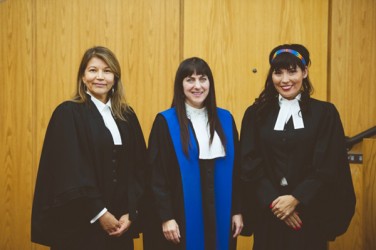Article Origin
Volume
Issue
Year
Melissa Daniels, a member of the Athabasca Chipewyan First Nation, wanted her Indigenous culture to be an integral part of her call to the bar. She also wanted to highlight the strength and leadership of Aboriginal women. These goals led to a ceremony that was steeped in tradition for family and colleagues who gathered in an Edmonton courtroom this past summer.
All three participants in the ritual were Indigenous women, a first in Alberta according to Daniels’ research. Provincial Court Judge Danielle Dalton agreed to preside, and Daniels’ maternal aunt Jude Daniels, who is senior legal counsel for TransCanada Pipelines, made the application to the Law Society of Alberta on Melissa’s behalf.
The ceremony began with a smudging by Elder Rose Wabasca. “I asked if we could smudge the courthouse,” said Daniels, “because you can only imagine the things those walls have seen.”
After court was called into session, Judge Dalton said a prayer in Cree. “I wasn’t aware she was going to do that,” Daniels said. “I wore moccasins, and the courthouse smelled like sweetgrass and sage.”
Daniels was granted permission to affirm her oath on an eagle feather, highly symbolic in Indigenous culture.
“I dedicated the day to children who lost their lives at the residential schools, and to those who never went back to school, and to those who lost their treaty rights by going to university,” she said. “I gave thanks to the really pivotal women I had studied in law school, how they united us and we were able to move forward in solidarity.”
Studying law was a second career choice for Daniels, who graduated as a registered nurse in 2004. Her mother and grandmother are both nurses as well, and it seemed like the right path to take. “There were so many opportunities,” she said. “I was doing outpost nursing right away then moved into public health, then right into academia.”
The things she learned as a nurse ultimately lead to the decision to study law. Working in Fort Smith, which is just downstream from Fort Chipewyan, Daniels learned about the research of Dr. John O’Connor, who first established that there could be a link between the tarsands and the people living downstream.
“I started to get very concerned about what was happening. He was my inspiration to go into law, because I wanted to find a way to protect my home community from the tarsands,” she said.
While the decision was daunting, she said having a family member who was a lawyer helped her realize she could do it.
Daniels received her Juris Doctorate from the University of Saskatchewan in Saskatoon in June 2011 and started her Masters of Science studies at Harvard University in Cambridge last September, with a concentration on atmospheric and water contamination. For now, she has dropped her Harvard studies to part time, but she wants to do her PhD in public health and policy. “I want to be able to make some strong recommendations to protect the people who live around industrial development that causes contamination, using what I’ve learned in environmental law, health sciences law and environmental science.
“My passion for water protection stems from the belief that water is living and women, as the traditional stewards of the water, must ensure it remains sacred by providing it with a voice.”
And Daniels has another goal. “I’ve always wanted to win a Nobel Prize, and a lot of Harvard grads do that.”
Presently, Daniels works with Frigault Law, in Edmonton, where her responsibilities include representation for claimants in the Indian Residential School Independent Assessment Process and providing legal advice to not-for-profit corporations.
If that happens, her Aunt Jude won’t be surprised. She says that her niece has always known the importance of education. “When Melissa was a little girl, the worst thing she could say to her mother was ‘I’m not going to university! And I’m not going to college either!’”
Things have changed a great deal over time. According to the 1927 version of the Indian Act, First Nations people were not allowed to attend university without giving up their status. “When you think about it,” said Jude, “Indian people were not allowed to vote federally until 1965.”
Jude was admitted to the bar herself in 1997, after working for several years as a social worker in child welfare. She saw some difficult situations in that role, and wanted to make a difference.
Jude is optimistic about the future. “There are so many opportunities for our Indigenous youth today. They’re proud of their culture, proud of their heritage and they want to make change in the world. It is an exciting time to be an Aboriginal Canadian.”
- 3302 views

